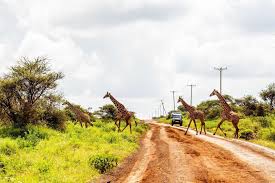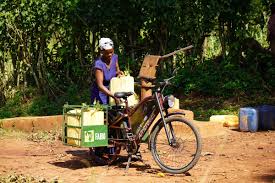
1. Context: Why this convergence matters
E‑mobility (electric two‑ and three‑wheelers, solar‑powered trikes, and e‑buses) is gaining momentum in Kenya thanks to its largely renewable electricity grid, surging fuel prices, and pressing needs to reduce transport emissions IntechOpen+13Reuters+13CleanTechnica+13. Meanwhile, Kenya is home to rich Indigenous Knowledge (IK) traditions—deeply rooted, place‑based cultural practices that inform land management, social organization, sustainability, and mobility decisions Emerald.
Bridging modern e‑mobility technology with Indigenous knowledge systems offers more than cleaner transport—it fosters socially inclusive innovation, leveraging local custodianship, sustainability ethics, and resilience. This combination aligns with Kenya’s climate targets and promotes gender and rural equity simultaneously.
For more: https://africaciviclens.com/
2. Five impactful ways they intersect
1. Empowering rural mobility through solar‑powered charging hubs and community ownership
The Sun Run initiative—led by E‑Safiri and Kiri EV in partnership with Sustainable Transport Africa and Glasgow Caledonian University—deploys solar‑powered charging hubs and EVs (e‑bikes, e‑tuk tuks) in rural, market‑dependent communities around Kisumu county, including Dunga Beach and Lake Victoria shoreline villages Siemens Stiftung+2NextBillion+22030.solutions+2.
These models reflect Indigenous values of community collaboration, shared assets, and energy sovereignty. The hubs double as local micro‑grids supplying cold storage and lighting—services especially empowering for women farmers and fish vendors. Women from local community‑based organizations (CBOs) lease and use the vehicles, transforming transport access into economic opportunity.
2. Cultural adaptation of traditional vehicles: emKoko electric mkokoteni
In Embu County, Ecomobilus Technologies electrified the traditional mkokoteni (hand‑pulled carts used by informal traders) by converting them into motorized electric counterparts—called emKoko—powered by repurposed lithium cells and solar chargers Antarctica Global+4NextBillion+42030.solutions+4CleanTechnica.
This innovation blends Indigenous transport design with solar‑battery technology, preserving the cultural form of the mkokoteni while increasing efficiency and reducing labor. It enables informal traders—deeply embedded in Indigenous urban and rural systems—to move goods more sustainably and at lower cost.
3. Battery‑as‑a‑Service (BaaS) and inclusive, place‑based energy models
One of the most transformative trends in Kenya’s e‑mobility sector is the emergence of Battery‑as‑a‑Service (BaaS)—a business model where users pay to swap batteries rather than purchase them outright. Startups like Ampersand, Ecobodaa Mobility, and BasiGo have led this charge. These companies have strategically established battery‑swap stations throughout Nairobi and other urban centers, enabling riders to swap depleted battery packs for fresh ones in minutes. This model elegantly sidesteps two major barriers: the high upfront cost of batteries and the scarcity of reliable charging infrastructure Wikipedia+10AP News+10Reuters+10.
How BaaS Works—and Why It Matters
At the heart of BaaS is a simple yet powerful idea: treat the battery as a shared, serviceable asset rather than a commodity. For example, Ampersand riders lease or purchase electric motorcycles without batteries, and pay just around $1.48 to swap for a fully charged pack—enough to travel 90–110 km AP News+1AP News+1. Compare that to about $1.44 of petrol for only 30–40 km on a traditional bike, and the financial incentive becomes clear AP News+1AP News+1.
Ecobodaa Mobility takes a similar approach: they offer electric motorcycles equipped with two batteries, enabling up to 160 km per charge while keeping cost comparable to petrol bikes—about KES 185,000 (USD 1,400) without batteries Reuters+6AP News+6AP News+6. Crucially, users don’t bear the penalty of battery depreciation or replacement costs.
Community-Centered Deployment: Reflecting Indigenous Resource Practices
This BaaS model resonates deeply with centuries-old Indigenous systems of communal resource stewardship, where vital assets—such as water sources, grazing lands, or communal forests—are shared within the community in accordance with collective norms Wikipedia+5IDRC+5Sustainability Directory+5. Just as communities historically shared responsibility for managing land and resources, today’s riders share battery packs that are maintained and cycled by the provider network.
Such communal stewardship emphasizes responsible use, maintenance, and ensuring the future availability of vital assets—all principles that guide Indigenous ecological systems Sustainability Directory. Similarly, Kenya’s BaaS model promotes accountability around battery health, safety monitoring, and efficient deployment, all overseen by the swap network provider.
Solar Integration and Infrastructure Leverage
Kenya’s grid is powered by nearly 90% renewable energy, primarily geothermal and hydropower RedditCleanTechnica. To amplify the sustainability of BaaS, firms like Ampersand have partnered with CrossBoundary Energy to integrate off-grid solar-powered charging at swap stations. A pilot in Nairobi installed 37 kWp solar arrays feeding 150 battery packs—enabling clean charging on top of grid supply Reddit+4CleanTechnica+4CrossBoundary Energy+4.
This solar‑backed BaaS model enhances energy sovereignty and supports rural electrification—mirroring Indigenous systems that harness local energy sources like sun, wind, or seasonal rivers in place‑based ways.
Economic Inclusion and Access in Underserved Communities
Because BaaS dramatically lowers entry costs, these e‑mobility services are accessible to commercial riders, small business owners, and rural artisans who rely on motorcycles or tuk‑tuks (boda‑bodas and tuk‑tuks) as their livelihood backbone . Ampersand and Ecobodaa’s learners report daily savings of 35–50% on operating costs compared to petrol vehicles—significantly improving their income margins AP News+3thinkenergymedia.com+3Reddit+3.
BasiGo, better known for e‑buses, also applies BaaS through “pay‑as‑you‑drive” leases of buses that come with separately leased batteries at a per‑kilometer fee, removing upfront battery costs and unlocking fleet access for local matatu operators Benjamin Dada+5Wikipedia+5Reuters+5.
These models mirror Indigenous principles of mutual aid, economic cooperation, and community-based access, where resources—tools, land, or labor—are shared and maintained collectively.
Environmental and Circular Economy Benefits
Because the companies, not individuals, own BaaS batteries, they can implement centralized maintenance, quality controls, and battery health procedures, reducing early failures and boosting lifespan. This centralized system also allows for planned recycling, repurposing of second‑life packs (for solar storage, off‑grid appliances), and environmentally sound disposal.
This reflects Indigenous ecological ethics that prioritize minimal waste, resource reuse, and communal well‑being—approaches validated over generations .
Challenges and the Path Forward
While BaaS is proving effective, scaling it further will require:
- Legal frameworks and policy support: Standardized regulations for battery ownership, safety, recycling, and vehicle licensing are still emerging.
- Infrastructure roll‑out: Battery‑swap stations are concentrated in Nairobi; rural areas remain underserved.
- Data and interoperability: Shared standards between providers can enable riders to swap batteries across networks.
A Blueprint for Inclusive, Indigenous-Aware E-Mobility
Kenya’s BaaS model—anchored in swap‑station networks, solar hybrid charging, and shared‑asset economics—offers a compelling blueprint for inclusive, Indigenous‑aligned energy systems. Its striking parallels with traditional resource stewardship underscore a powerful truth: modern tech and ancient wisdom can evolve hand in hand, not at odds.
By viewing batteries not as private, depreciating assets but as community-managed utilities, Kenyan startups are balancing innovation with cultural continuity, financial access, and environmental care. They demonstrate that e‑mobility isn’t merely a technological shift—it’s a social and ecological transformation, where place‑based energy solutions reflect and reinforce the values of the communities they serve.
4. Gender inclusion and leadership through community‑based deployment
By co‑designing interventions with women’s groups, e‑mobility projects are integrating gender equity and Indigenous socioeconomic knowledge into implementation. For example, women comprise only a small share of boda‑boda drivers in Kenya (<5 %) but participate significantly in EV company operations (23–38 %)—though female founders remain underrepresented (<5 %) NextBillion.
Sun Run targets women smallholder vendors via tailored training programs that teach driving and maintenance of EVs, overcoming barriers to adoption. By involving local CBOs and training women in traditionally male‑dominated transport roles, the projects apply Indigenous community knowledge and social structures to drive inclusion.
5. Circular economy, second‑life batteries, and Indigenous environmental ethics
Ecomobilus began with second‑life lithium batteries salvaged from laptops to power early EV conversions and solar systems at a fraction of commercial cost Siemens Stiftung+9CleanTechnica+9NextBillion+9. Additionally, Siemens Stiftung supports Kenyan enterprises in battery e‑waste solutions, battery reuse and shredding research, and circular economy practices Siemens Stiftung.
These practices build upon Indigenous ecological sensibilities—valuing reuse, minimal waste, and resource stewardship. By recycling battery cells and designing for longevity, Kenyan e‑mobility innovators align their technological models with long‑standing local values around sustainability and communal resource care.
3. Critical enablers driving the convergence
• Renewable grid and energy surplus
Kenya’s electricity is over 85 % renewable—primarily geothermal and hydro—and the country generates a surplus of 25–30 % at times, making transport electrification both feasible and climate‑responsible CleanTechnica+1Reuters+1MDPI.
• Emerging policy frameworks and incentive ecosystems
Kenya’s Draft National E‑Mobility Policy (2024) outlines supportive measures around charging infrastructure, local EV assembly, and financial incentives. Local plans—such as Kisumu’s Sustainable Urban Mobility Plan targeting e‑tuk tuk and boda electrification by 2025—are now taking shape MDPI.
These policies help channel innovation into socially inclusive and place‑based models tied to Indigenous communities and their knowledge systems.
• Public‑private partnerships and funding
Programs like P4G, supported by UNEP and WRI, channel grants and technical support into rural and gender‑inclusive mobility models. For example, Sun Run and ACTS‑powered efforts rely on blended grant and private funding to embed capacity‑building and community engagement in their business models NextBillion.
4. Challenges and opportunities ahead
In Kenya’s e‑mobility transformation, intertwining modern electric transport with Indigenous knowledge (IK) unlocks both profound promise and complex challenges. Recognizing these forces is essential to building an inclusive, culturally respectful transition.
⚠️ Challenges
1. Under‑documented Indigenous Knowledge and Weak Legal Protection
Although Kenya’s 2016 Protection of Traditional Knowledge and Cultural Expressions Act (TKCEA) marked a legal milestone, the legislation remains largely ambiguous and under-enforced. The Act grants communities collective rights over TK, including the ability to authorize or prevent use, yet its implementation has been hampered by unclear oversight, vague definitions, and weak institutional structures Reddit+7IP Kenya+7Emerald+7Emerald+6katibainstitute.org+6CFL Advocates+6.
For example, the Act lacks clarity on which national ministry or agency holds responsibility, leading to fragmented enforcement. County governments are nominally involved, but coordination between national and local bodies is inconsistent . Additionally, while the law prohibits unauthorized TK use, its high penalties—even five-year prison terms and steep fines—have frightened both Indigenous custodians and potential collaborators, potentially stifling new cultural creations rather than protecting them .
Compounding these legal gaps, much Indigenous knowledge remains undocumented or oral, meaning communities lack the formal records or repositories (like the proposed Traditional Knowledge Digital Repository) needed to assert their rights effectively The Free Library+2The IPKat+2Reddit+2.
2. Fragmented Policy Adoption and Regulatory Gaps
Kenya has national-level strategies—such as the Green Economy Strategy, the National Climate Change Action Plan, and the E‑Mobility Taskforce—but local implementation varies widely Reddit+6SpringerLink+6BioMed Central+6. While Nairobi benefits from incentives like EV tax relief and nascent battery‑swap stations, many municipalities remain far behind in integrating e‑mobility into local urban planning, transport permits, or charging infrastructure Reddit+6BioMed Central+6SpringerLink+6.
Research highlights that vertical policy integration—connecting national visions to local execution—remains weak in secondary cities like Kisumu, where regulatory clarity, safety standards, and infrastructure coordination are still emerging AP News+7Reddit+7BioMed Central+7. This regulatory fragmentation discourages investment and complicates deployment outside urban centers.
3. Financial & Technical Barriers
EVs remain costly up-front despite long-term savings. Electric motorcycles—vital in Kenya’s informal boda-boda economy—require substantial initial investment, often beyond the reach of rural or female operators BioMed Central+1Reddit+1. Although models like BaaS reduce entry fees, access to financing remains limited, especially for women and young entrepreneurs.
Technically, e‑mobility relies on charging infrastructure—yet outside urban hubs, these remain few and unevenly distributed BioMed Central+1Reddit+1. The national grid’s instability in rural areas further complicates reliance on electric vehicles, and a lack of trained technicians means repair, maintenance, and battery disposal services are inadequate and often expensive BioMed Central.
Opportunities
Despite these barriers, emerging opportunities suggest a path toward a more just and culturally grounded e‑mobility future.
1. Deepening Co-creative Models
Co-creation—with Indigenous custodians and community-based organizations (CBOs)—can ground e‑mobility solutions in local values, languages, and decision processes. Collaborations might include training Indigenous mechanics, co-designing solar charging hubs, and launching pilot fleets that integrate traditional transport forms alongside community governance models. Embedding Indigenous voices enhances both uptake and cultural legitimacy.
2. Formalizing Indigenous Knowledge Protection
Reforming TKAEA implementation is vital. Clarifying ministry roles, funding the digital repository, and ensuring meaningful “prior informed consent” can empower communities to protect and benefit from their knowledge. Legal amendments to streamline dispute resolution, remove overly punitive fines, and allow for derivative cultural innovation could stimulate collaboration rather than suppression katibainstitute.org+2IP Kenya+2The IPKat+2. Ultimately, benefit-sharing agreements can offer a model for equitable partnerships between startups and Indigenous custodians.
3. Scaling Circular‑Economy Models
Battery reuse, recycling, and second‑life applications align closely with Indigenous environmental ethics—valuing resource longevity, waste reduction, and communal stewardship. Expanding initiatives in rural Kenya to retro-fit used EV batteries for solar storage or micro‑grids could generate income for local artisans, open rural electrification pathways, and reflect Indigenous resource cycles. Training programs tied to local manufacturing and repair could foster green entrepreneurship.
4. Inclusive Workforce Development
Targeted training can equip women, youth, and Indigenous workers to participate in driving, maintenance, assembly, and charging network roles. Delivered in local languages and contexts, an inclusion-first approach could dismantle gender and geographic barriers, catalyze economic empowerment, and involve communities in technical co-creation and planning. By integrating local values and customary practices, training becomes culturally resonant and practically effective.
Envisioning a Path Forward
Bridging the challenges and opportunities in Kenya’s e‑mobility landscape demands integrated action across legal, policy, financial, cultural, and environmental domains:
- Legal safeguards: Fully operationalize the TK digital repository, clarify institutional responsibility, and align the Act with co-creative innovation goals.
- Policy coherence: Strengthen vertical coordination—ensuring national e‑mobility aims are translated into clear local transport and planning frameworks.
- Financial inclusivity: Expand financing and leasing models tailored to women and rural entrepreneurs, supported by public incentives.
- Technical infrastructure: Broaden charging and battery-swap networks outside urban centers, leveraging renewable integration.
- Circular pathways: Scale battery reuse and recycling while embedding local value chains and training.
- Cultural integration: Co-create vehicles, delivery models, and distribution networks in partnership with Indigenous knowledge‑holders.
By embracing Indigenous knowledge not as a mere footnote but as an active partner in shaping e‑mobility, Kenya can forge a transition that is technologically advanced, culturally rooted, economically inclusive, and environmentally ethical. Success will require honoring custodianship, reforming legal regimes, bridging policy divides, and designing inclusive, circular systems that reflect Kenya’s diverse communities—ensuring a green future where innovation and tradition walk hand in hand.
5. Toward a future where e‑mobility and Indigenous knowledge thrive side by side
Kenya’s e‑mobility sector is not merely about low-carbon transport—it is rapidly evolving into a socially embedded, culturally aligned transformation. By centering rural communities, women, and environmentally conscious Indigenous wisdom, these five pathways show how modern technology and age-old knowledge can create inclusive, sustainable mobility.
From the emKoko trikes on farms to solar‑powered hubs by lakeshores—these models preserve traditional forms while empowering new possibilities. They are blueprints for other nations seeking equitable green growth—and for Indigenous communities to lead in defining innovation on their own terms.
External links for further exploration
- Ampersand, Ecobodaa & BasiGo e‑mobility initiatives in Kenya and battery‑swap models NextBillion+1IntechOpen+1Emerald+1IntechOpen+1CleanTechnicaNextBillion+4AP News+4Reuters+4
- Sun Run partnership: E‑Safiri & Kiri EV’s rural, women‑centred e‑mobility project near Lake Victoria NextBillion+12030.solutions+1
- Ecomobilus Technologies and the emKoko electric mkokoteni story CleanTechnica
- World Resources Institute and UNEP analysis on Kenya’s e‑mobility policy, workforce inclusion and emissions impact World Resources Institute
- Legal review of Indigenous Knowledge protection in Kenya Emerald
Table of Contents
The post by: https://afripoli.org




